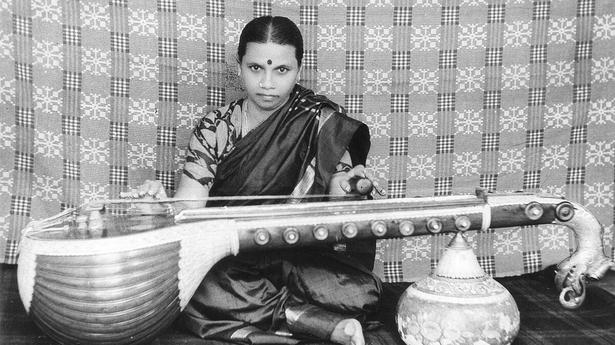
Savitri Ammal, the first woman gottuvadyam artiste
The Hindu
In her centenary year, recalling how Savitri Ammal made history by challenging gender stereotypes in Carnatic music
The world of Carnatic music has seen many great practitioners of the gottuvadyam. Abraham Pandithar’s Karunamruta Sagaram mentions that the famous composer and Harikatha artiste Harikesanallur Muthiah Bhagavatar was a skilled gottuvadyam artiste as well. Thiruvidaimarudur Sakharama Rao is credited with bringing the string instrument back into concerts. While artistes ‘Gottuvadyam’ Narayana Iyengar, Budalur Krishnamurthy Sastrigal, ‘Gottuvadyam’ Narayana Iyer, and Thanjavur Duraiyappa Bhagavatar are known to have carried forward Sakharama Rao’s legacy, their contemporary, Mannargudi K. Savitri Ammal, is often overlooked.
Between 1940 and 1950, it was only four times that a gottuvadyam concert got featured during the December Music Season at the Madras Music Academy. The fact that three of these featured Savitri Ammal, who was only in her twenties then, is proof of her talent.
Born on June 19, 1922, Savitri Ammal belonged to the Isai Vellalar community. She began learning vocal music from Srirangam Iyengar, but it was gottuvadyam that enamoured her, and she went on to learn the intricacies of playing the instrument from Kambangudi Narayana Rao. She also underwent special training to master the rhythmic aspects of Carnatic music under konnakkol stalwart Mannargudi Vaidyalingam Pillai.
Such intense training helped her gain confidence and proficiency to perform concerts at the age of 13. According to her son Gandhi, “She was a sought-after artiste, who performed in and around Thanjavur. For better access and mobility, she moved out of Mannargudi and settled down in Kumbakonam.” She used to share the concert platform with her husband, violin vidwan Krishnamurti Pillai. A review of her radio performance that appeared in Kalki in 1947, declares her as one of the foremost exponents of the instrument at that time. The archives of ‘Indian Listener’ reveal that she was a regular performer at AIR Tiruchi, and that she also performed several times in the National Programme relayed from Delhi.
She had released the songs, ‘Mundhu Tamil maalai’ and ‘Arunodhayam’ as 78 rpm records. Unfortunately, the recordings are not accessible. However, a concert recording of Savitri Ammal was uploaded recently on the YouTube channel of mridangam artiste K.S. Kalidas.
The recording stands as a true testament to her mastery. In her exposition of ragas Kalyani, Nattakurinji and Thodi, what stands out is the serenity. She depicts the ragas with plenty of short, but nuanced phrases. Her effort to present every phrase with perfection is evident. Her use of meaningul pauses between phrases elevate the overall aesthetics of the alapana. The emphasis is on showcasing her musical depth and not on exhibiting her virtuosity. Savitri Ammal’s playing of the kritis is sensitive and close to the vocal rendition of the songs. It is not surprising since she is known to sing while playing the instrument. One review of her performance in 1946 particularly praises her singing. In fact, her 1943 performance at the Music Academy is listed as a gottuvadyam and vocal concert.
In the 1960s, she joined the Padmavati College of Arts in Tirupati as faculty and worked with two other renowned women instrumentalists, Pudukottai Ranganayaki Ammal and Dwaram Mangathayaru.











